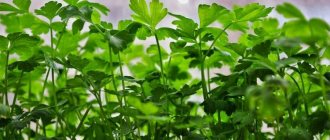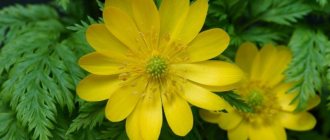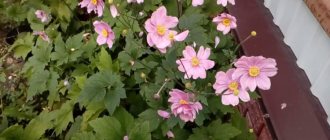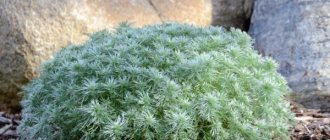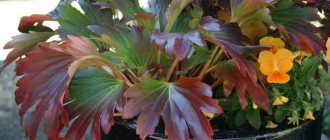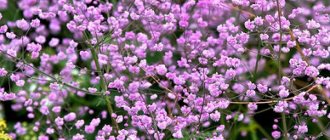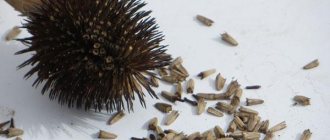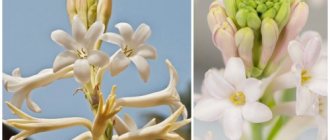Caring for thuja at home outdoors
Thuja is a plant that should be properly cared for and know the nuances for each season. The main thing in caring for a tree is the correct location and watering regime. By following the main rules, you can achieve excellent results and enjoy the green beauty.
At the summer cottage
You need to start caring for the tree immediately after winter. Care should be continued in spring, summer and autumn. The mistake of many gardeners is to be too reckless with the plant. In their opinion, she is not at all picky and does not require special attention. But this is wrong, and gardeners end up with dull, yellowed or blackened bushes. But it is quite possible to avoid these consequences if you properly organize the care of the thuja.
For your information! The most common varieties of thuja are: Smaragd and Brabant. They do well in temperate climates.
Basic rules of care
Only proper and regular care of the thuja will allow it not to lag behind in growth and not get sick. Let's consider the main recommendations:
- An area with partial shade or low light is suitable for growing. The soil must be fertile, then the crown will be lush and bright.
- In summer, thuja needs regular and abundant moisture. You can use warm, settled water.
- Fertilizing should be done from late spring to early autumn. Specialized formulations for coniferous crops are best suited.
- Regularly inspect the plant for insects and diseases. For example, if the needles are covered with unsightly dark spots, then these are sunburns, which are difficult to get rid of.
Features of spring care
What year does hydrangea bloom after planting?
Spring is the most important period in caring for thuja. After winter, the plant is weak, and any environmental influence can be destructive: the needles will begin to turn red. In winter, the trees are covered with airtight material. Due to the first spring sun, the needles and root system can burn out, which will lead to drying and yellowing of the plant or even death.
Important! It is recommended to open thujas only after the snow has melted and the soil has warmed up, that is, after the root system has awakened.
The soil should also be prepared. To do this, even during planting, it was worthwhile to provide a high-quality drainage layer and mulch the soil. A large amount of moisture for thuja can be destructive. In addition, the ground around the plant must be cleared of grass and loosened to provide sufficient air.
The irrigation regime must be established as early as April, and in some regions in March. This is due to the fact that with the first sun, moisture begins to evaporate, which needs to be replenished. In the spring months, it will be enough to water the thuja once a week at the rate of one bucket of water per tree. In addition, it is recommended to sprinkle the needles weekly.
The next step is to remove the dead branches. All yellowed needles must be trimmed. On large trees, damaged branches may be located in the very middle, so it is worth carefully inspecting the plant.
Note! The ideal time for pruning is April. But, even if time has been lost, it is worth carrying out the procedure at the first opportunity.
Diseased plants
Spring is the time when it is necessary to feed young trees that are just gaining growth. Fertilizers are applied as soon as the snow melts. Both organic and mineral fertilizers are an excellent option. You can also find specialized pine fertilizers. Before fertilizing the plant, it is worth watering and mulching the soil well so that the fertilizers are better absorbed.
Important! Too much fertilizer can ruin the plant, so it is worth diluting the products according to the attached instructions.
How to choose a good seedling
Often, thuja seedlings are sold with a closed root system in a pot (container) or wrapped in burlap with a lump of earth.
Advice! It is better to choose a young seedling no more than 3-4 years old. He will begin to grow faster than an older one.
The seedling must meet the following criteria:
- It has a symmetrical crown.
- The crown is lush.
- The needles are light or dark green (however, there are varieties with yellow or golden needles).
- The seedling should not be brown; if it is dark brown, it does not receive enough nutrients.
- The plant's roots may stick out slightly from the drainage holes in the pot. If they stick out too much, such conifers will not be sold for a long time.
- There should be no damage to the bark or signs of disease.
- If you squeeze the needles in your hand and they quickly recover and straighten after letting go, then the tree is healthy and alive.
- The root system is checked as follows: the seedling is lifted by the upper part. If it slips out of the pot, it means the roots have not taken root in the ground or they were torn off during replanting.
- Don't be afraid if weeds grow in a pot. This means that the thuja has already overwintered in this pot for at least one season and has become stronger, having adapted to local conditions.
- If possible, you should inspect the roots. They should be white with a pinkish tint. Saplings with brown and soft roots should not be planted, as this is an indication that the roots have begun to rot.
Watch the video! How to choose a thuja variety
Rules for summer care of thuja
During the summer months, evergreen plants require combined and regular care. Watering and sprinkling, loosening the soil, removing weeds and applying fertilizers are mandatory.
When to dig up hazel grouse after flowering and how to store it before planting
How often to water thuja in the hot months is a question that worries many gardeners. At average temperatures, watering and sprinkling is sufficient once a week; in hot weather, it can be increased up to twice. After a couple of days, the soil should be loosened to saturate it with air.
For your information! Summer is great for shaping the tree.
Features of caring for thuja in autumn and preparing for winter
Caring for thuja is necessary throughout the year, but each period has its own characteristics. In autumn, the tree prepares for winter, so in September it is worth stopping feeding the plant in order to stop the growth of young shoots.
Spraying fruit trees in spring before and after flowering
In late autumn, thuja is prepared for wintering. To do this, the branches are tied, the most rolling and crooked ones are cut off, and the soil is mulched. To protect from wind and sunlight, the bushes should be covered with an airtight fabric and left until spring.
Features of preparation for winter in different regions
In regions where there is heavy snow and wind in winter, such as the north-west of the country, it is recommended to create additional protection for the bushes from wooden panels. In the middle zone, you can get by with loose material.
Important! In conditions of little rain, the plant should be thoroughly watered before wintering.
Types and varieties of thuja
A description of the most popular varieties of thuja will help you choose exactly the one that will look best in your flower garden. The variety of thuja is simply amazing.
Type of thuja trap. This species is native to eastern North America and eastern Canada. In nature it reaches almost 30 m. This common species became the ancestor of more than 120 varieties of thuja:
- Smaragd is a universally recognized best variety with a narrow conical crown that retains its shape over the years. Reaches almost 3 m. The needles retain their green color even in winter. They look impressive in a hedge.
- Golden Smaragd is a derivative of the Smaragd variety. Thuja Golden reaches a height of 2 m. The variety is colored golden-yellow, so the western thuja variety Smaragd Golden is intended for the sunny side.
- Brabant is a well-known variety that is mainly used to create living fences. It grows quite quickly and has a column-shaped crown. The green needles at the tips are colored golden.
- Golden Globe - has the shape of a ball. Thuja variety Golden Globe has green needles, colored golden yellow at the tips of the shoots. Closer to cold weather, the whole plant takes on a copper tint. Grows slowly - 10 cm/1 year.
- Heather-shaped (Eriсoides) – heather-shaped thuja is a relatively young variety. This shrub, more like a juniper, reaches 1 m in height. At the top, the greenery has a golden hue.
- Pancake – this dwarf thuja is a wonderful resilient variety. Thuja occidentalis variety Pancake reaches a height of only half a meter. She endures winter without shelter. Its spherical crown does not turn yellow from sunlight, but turns blue in autumn and winter. Looks great in rock gardens and rockeries.
- Maria (Mariya) - this variety has a conical shape, grows slowly - 20cm/1 year. Thuja occidentalis variety Maria does not change its golden yellow color throughout the year. Looks good both in single plantings and in a hedge, container, or on the balcony. The variety is resistant to fungal diseases. Choose a sunny location for planting.
- Golden Hills (Golden Tuffet) - the needles below and inside are light green, and above - yellow-green-red. Reacts well to pruning. In winter, it may not withstand the load of snow, so it is better to tie it up. Thuja occidentalis variety Golden Hills loves sunny places and looks harmonious in flower arrangements.
- Golden-tipped (Aureospicata) - this variety deserves its name because the dark green needles acquire a golden color at the ends in summer. Thuja occidentalis variety Zolotistokonchikovaya can grow in the shade and is not picky about soil. The variety is resistant to frost. Looks good in a hedge, single or group planting.
- Tip Top - this shrub is very compact: 0.8 m in height and 0.3 m in width. The crown has a spherical shape. The dark green dense crown is not afraid of sunny places, as well as drought and frost. But what the western thuja variety Tip Top does not like is the spring sun, from which it gets burned, especially in young plants. Therefore, it is better to cover them. Looks good in single plantings and borders.
Thuja orientalis species. The homeland of this species is China, or more precisely the mountains in northern China. The symbol of Beijing are specimens that are supposedly about 1000 years old. The most common varieties of oriental thuja:
- Book - this decorative variety is very valuable and popular in the eyes of gardeners. It grows slowly - 10 cm/1 year, reaching an average of 3 m in height. Looks good in a hedge against the background of dark spruce and yew needles. Thuja book loves heat, so it should not be grown north of Voronezh.
- Golden Minaret - This thuja with bright yellow needles loses its color in the shade, so to maintain its individuality, plant it in a sunny place, but avoid wind and drafts.
- Pyramidalis - an adult specimen has a columnar shape. It reaches a height of 4 m and a width of 1.5 m. It grows well in the shade, so if you don’t know what to plant against the wall of a house or under a tree, Thuja Pyramidalis will help you with this.
- Morgan – Australian botanists worked on developing this variety. In summer the plant is lemon green in color, and in winter it is red-orange. The crown is dense and pyramidal. Does not require special formation.
- Justinka (Justinka) - this dwarf thuja comes from Poland. The crown grows in the shape of a column. Justinka is resistant to frost.
- Aurea Nana (Aurea Nana) is a decorative slow-growing variety 10 cm/1 year. Like other low-growing thujas, Aurea Nana can decorate any area. This variety looks attractive due to the golden color of the crown.
- Melldensis (Melldensize) - has an ovoid crown shape. The green-blue needles darken in winter. This blue thuja looks amazing on the site.
Korean thuja species. This species is a rare visitor to landscape areas; more often it can be found in greenhouses. The natural environment of this species is Korea and China, and there, in the natural environment, arboreal forms of this species are more often found. Slow growing species 3m/10 years. The color of the needles is pale green, white-silver underneath, due to which the Korean thuja always looks elegant. Frost-resistant species, loves moist, rich soils.
Type of thuja foldata. In nature, this tree reaches enormous sizes - up to 60 m (hence the second name of the species - giant thuja). The needles are green with a white stripe on the underside. Due to the height of this species, it is planted mainly in parks.
Thuja japonica species. From the name it is obvious where this species comes from - from Japan, or rather from its central part. The Japanese love for attaching sacred significance to plants led to the fact that the Japanese thuja was banned from being cut down. The wild plant reaches 20m, the cultivated plant reaches 9m. Green needles have a matte finish. The species is frost-resistant, but does not like drought.
How to care for thujas after planting
After planting, the shrub requires special attention. Caring for newly planted thujas depends on time. If the shrub was planted in summer or spring, you will need:
- weekly watering in warm weather and twice a day in hot weather. For irrigation, it is better to use water at room temperature;
- Spraying should be carried out once a week, and in hot weather daily in the evenings.
If the tree was planted in the fall, then:
- watering should be carried out in a similar mode as for spring and summer plantings;
- If there is heavy rainfall, watering must be reduced or stopped, since excess moisture is detrimental to thuja.
There is no need to feed the plants after planting. Fertilizers are applied during planting and are enough for the next two years.
When and how to plant
Spring, summer and autumn are suitable for planting thuja. Gardeners recommend spring so that the young tree has time to get stronger before the first frost.
Before planting, you need to make sure that the seedling is healthy and ready for planting. The needles should be green and not fall off, and there should be no visible damage on the trunk. For planting, it is best to choose a place protected from direct sunlight, slightly shaded.
The soil for planting must be prepared in advance. The soil must be moist and free of clay, otherwise the bush will be susceptible to yellowing. Also, you should not allow too much humidity, as this can cause the greenery to fall off.
Planting technology:
- Dig a hole depending on the size of the root system, but at least 80 cm deep.
- Place expanded clay on the bottom, making a drainage layer.
- When planting thuja in the spring, add fertilizer to the soil mixture; it is not necessary in the fall.
- Place the seedling in the hole, slightly deepening the root collar.
- Cover with soil and compact.
After planting, follow the recommendations for caring for seedlings.
How often to water thuja
The watering regime for thuja depends on weather conditions. It is recommended to water the plant for the first time in the spring. In the warm season, the shrub should be watered once a week at the rate of one bucket per average tree. In hot weather, watering should be increased to 2 times a week. It is best to use water at room temperature.
Sprinkling should also be carried out regularly once a week. When the temperature rises, you can moisten the needles daily.
Proper watering of thuja
Planting thuja in open ground
As already noted, the best time for planting is spring, April-May. Before winter, the plant will have time to get stronger and adapt, which means it will tolerate low temperatures well. You can plant thuja in open ground in the summer, with the only difference being that in the hot season the seedling will suffer more from drought, so it will have to be watered more often. As for autumn, there is a possibility that the plant will not have time to get stronger before the onset of cold weather, in which case it will need to be carefully covered for the winter.
To properly prepare for planting thuja, use step-by-step instructions from experts.
- Choosing a location. For planting, you need to choose a sufficiently lit place that will not be constantly exposed to direct sunlight, because of this the tree will become dehydrated and will not survive the winter well. The best option is an area with good lighting, which is shaded at midday, without drafts. When growing in the garden, you should pay attention to its proximity to other plants. Thuja gets along well with other conifers, spirea, hydrangea, and acacia, but this plant does not tolerate birch, peonies, and asters as neighbors. Groundwater will benefit the thuja if it passes at a depth of at least 2 m from the root system; at a smaller distance, the plant will be flooded and die.
- Soil preparation. Thujas are undemanding to soils, however, slightly acidic or neutral compositions are preferred. The soil mixture is prepared from turf soil, peat and sand, or you can buy a ready-made mixture for coniferous plants in specialized stores.
- Pit. Prepare 2-3 weeks before the planned planting. The hole is usually dug 25-30 cm larger than the volume of the earthen ball with the root system. Depth – 80cm – 1 m. The roots should be placed freely in the hole. As for the distance for planting, between trees it varies from 1.5 to 5 m: it all depends on the type of thuja and the intended composition. Thujas should be located at least 3 meters away from other trees with a powerful root system.
- Landing. A 20 cm layer of drainage made of broken bricks and sand is placed at the bottom of the hole. The plant is carefully removed from the container along with the earthen lump. To prevent damage to the roots, water the thuja first. The seedling is placed in the hole, covered with prepared soil mixture. The soil is compacted so that there are no air pockets. After compacting the soil, the root collar of the seedling should be level with the ground surface. Large trees need support, which must be provided in advance, before planting the tree, so as not to damage the root system.
- Watering and mulching. After planting, the thuja is watered generously with 25-30 liters of water. After half an hour, the tree trunk circle is mulched with pieces of bark, sawdust, and wood chips to retain moisture and prevent weed germination.
Having followed all the recommendations for planting, to get results, all that remains is to properly care for the thuja outdoors.
How to make thuja lush
Its needles are of great importance for thuja. If it is healthy, then the plant will become lush and beautiful. To achieve this, you should start caring for the shrub in early spring and do this throughout the year. At the same time, monitor the watering regime and fertilizing. Fertilizers can be used organic and mineral. They should be applied from the first spring months and throughout the spring and summer, but in the fall it is no longer necessary. If the above conditions are met, the shrub in your summer cottage will delight you with its lush greenery.
Mandatory conditions are pruning the branches of the thuja and giving it various shapes.
Pruning diseased branches and forming a crown
Throughout the year, it is necessary to monitor the health of the thuja, and especially the branches. If dry or diseased shoots are found, they must be trimmed urgently.
The first inspection should be carried out in early spring, when the protective material is removed from the bush. All dry and damaged branches are pruned.
Large trees should be inspected more carefully, as infected parts may be located in the middle. You can prune thuja in spring and autumn. In the first case, pruning is carried out to give shape, and in the second - to prepare for winter.
According to general recommendations, only 1/3 of all branches should be cut at a time. It is better to carry out the procedure on a cloudy day, and at the end, thoroughly water the thuja.
The main thing is to choose the right tool for pruning branches.
The main mistakes when planting thuja
When planting this plant, the same typical mistakes are made as when growing most other varieties of coniferous bushes. In order to prevent their recurrence in the future, the main ones are discussed below:
- Damage to the earthen ball during transplantation into open ground. Abundant watering of the soil the day before replanting the thuja can help prevent this. It is also recommended to wrap the earthen ball in burlap or any other non-synthetic material, and then securely tie it with wire to fix the shape. In this case, when planting, it will be enough to remove only the wire; the burlap will still rot after being in the ground for a long time.
- Incorrect determination of the size of the planting hole. The earthen lump should not only enter into it without hindrance, but there should also be free space on all sides, into which the palm of an adult man can easily enter.
- Violation of planting technology, which consists of filling the root collar of the bush with soil. The plant is cleared of soil to the required level or air drainage is required.
- Ignoring the individual requirements of a certain breed for conditions. Thuja has a number of varieties, each of them has its own characteristics. You need to check them with the seller before making a purchase; it is for this reason that it is recommended to purchase planting material only from professional breeders and trusted sellers.
Pests and diseases
The most common bush pests include:
- thuja aphid;
- bark beetle;
- digitalis moth;
- spider mite
The most common diseases:
- Kabatina necrosis;
- pestalocyopsis necrosis;
- Phomopsis necrosis;
- brown shutte.
To control and treat pests and diseases, it is necessary to use special means and treat at the first signs of infection. But it is best to prevent illnesses and the appearance of parasites, so a thorough and regular inspection of the plant for harmful organisms is necessary.
